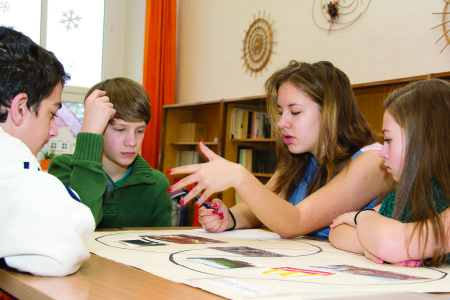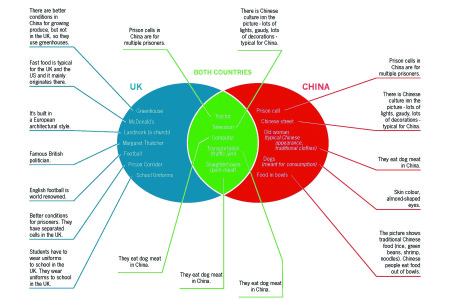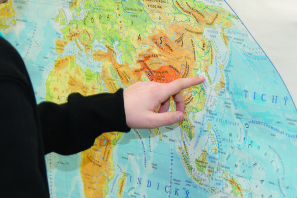Ours is a small (170 pupils) primary school in a socially marginalized location in the Czech Republic. We have pupils from the Roma and Vietnamese communities, from Ukraine and from multi-ethnic families.
Choice of activity
I trialled this activity with Year 8 pupils (age 13–15). Global Education topics are part of the curriculum. I chose China, UK or both? because of topics we were covering in our Multicultural Education. I wanted to know if knowledge gained in previous classes would influence the way the activity worked.
During the initial audit 13 pupils were present. To explain the concept of globalisation I showed them pairs of photographs (e.g. of a Czech actor and Justin Bieber; a medieval castle in Bohemia and the White House; a doe and a giraffe) and asked them to identify the images. They did not recognize people, buildings or animals that were geographically close but could instantly name the others. We discussed why this could be. The pupils understood that it is important to know both a giraffe and a doe; our lives are influenced by both global and local phenomena.
Initial audit
I presented the activity and asked pupils to find the United Kingdom and China on a map. While they instantly located the UK, China posed problems. Next I divided the class into three mixed-ability groups and gave each group a pack of photographs showing places and things in the UK or in China (e.g. students in school uniforms, football boots, a busy crossroads, a computer, agricultural machinery in a field, a church, a McDonald’s). I gave each group a sheet featuring a Venn diagram with circles entitled China and UK and intersecting at both countries on which to note their ideas. When this activity had been completed the class discussed the findings.
Football, school uniforms and McDonald’s were placed in the UK circle (though one pupil said that China has its own football league). Chinese food, a woman with Asian facial features and dogs being readied for food preparation were placed under China. Pupils came to a consensus that Chinese people eat rice and dog meat and that food there is served in bowls. In discussion, besides an idealized view of traditional China, pupils also mentioned bad conditions in prisons, and knew that most electronic products are made in China, even if they have a European brand name. They were also aware that Britain and China are linked through trade, and that it was impossible to tell where some photographs were taken. Interestingly, some pupils were aware that it was important to know what region of China was being discussed.
When one pupil moved the picture of McDonald’s from the UK side to the intersection, arguing that McDonald’s are everywhere, one classmate became angry and retorted that the Chinese were skinny and only eat rice and cats. But from further discussions and classes, pupils began to realize that there are few things in China that are very different from those in Europe.
One of the key outcomes of the activity was that it confirmed that pupils have a certain understanding of the interconnectedness of the world. They may also subscribe to particular cultural stereotypes. They know a lot, but cannot always use this knowledge to make necessary connections and to think globally.
My goal is to help pupils make connections between individual facts. I want to challenge their simplified view of the world and focus on the less well-known facts about the everyday life of people in different places.
Intervention
We continued exploring topics from the curriculum – racism, prejudice and the quality of interpersonal relationships – often returning to the photographs from the introductory activity. I discovered some specific opinions and prejudices of the pupils with regard to different nationalities or ethnicities.
For one activity I gave the class three anonymised news articles. One described the return of stolen money, another how someone fell from scaffolding and the third how someone was sentenced for procurement and fraud. Pupils were to decide the nationality of each protagonist. Most thought the money was returned by a German or an Italian (whom they consider to be honest), the man who fell was Ukrainian or Slovakian (these two nationalities often work in construction in the Czech Republic) and the criminal was a Roma (a group often connected to crime in this country). They were surprised to learn that a Czech returned the money, a Pole fell from scaffolding and the fraudster was German.
Final audit
After allowing four months to explore topics that could influence pupils’ opinions, I repeated the audit activity.
I again divided the students into groups, swapping around the packs of photographs. They worked with less enthusiasm than the first time, not understanding why they were doing the same activity again, and suggesting another set of photographs would have been better. Changes in opinion did occur, as expected. Students still believed that food eaten from bowls is typical for China. But while initially they had assigned some of the photographs automatically to one country, now, generally, they admitted that the photograph could come from either country.
In their decision-making process, pupils were more concerned about where the photographs were actually taken, and not whether the given thing or place could appear in either country. For example, they correctly identified Margaret Thatcher, but did not think further about what connections she may have had to China. Pupils did not go beyond the question Where was the photo taken? As soon as they saw a Chinese sign in the picture, they would stop analysing the photograph.
They selected the country easily, but sometimes had a problem giving a reason
The picture is of a Chinese woman.”
How can you tell?
Eyes, scarf and so on…
Pupils judged the photographs based on people’s appearance. The pupils had gained understanding of the Chinese culture being present in many countries: There are many Chinese communities in big cities in different countries.
However, pupils remain convinced that a Christian structure cannot be located in China. This is the reason I want to focus more on making the students’ knowledge more integrated, so they can use it to understand the context and make connections.
Initial audit
| Type of photograph | Country | Comments |
| School Uniforms | United Kingdom | Students have to wear uniforms to school in the UK.
They wear uniforms to school in the UK. |
| Tractor | Both countries | Both in China and in the UK people can harvest food with the help of machines. |
| Food in bowls | China | The picture shows traditional Chinese food (rice, green beans, shrimp, noodles).
Chinese people eat food out of bowls. |
| Prison cell | China | Prison cells in China are for multiple prisoners. |
| Prison corridor | UK | Better conditions for prisoners.
They have separated cells in the UK. |
| Greenhouse | UK | There are better conditions in China for growing produce, but not in the UK, so they use greenhouses. |
| Chinese street | China | There is Chinese culture inn the picture – lots of lights, gaudy, lots of decorations – typical for China. |
| McDonald’s | UK | Fast food is typical for the UK and the US and it mainly originates there. |
| Landmark (a church) | UK | It’s built in a European architectural style. |
| Television | Both countries | The brand may be British, but it could have been manufactured in China. |
| Computer | Both countries | Same as for television. |
| Transportation (traffic jam) | Both countries | In China and England there is a lot traffic |
| Dogs (meant for consumption) | China | They eat dog meat in China. |
| Old woman (typical Chinese appearnce, traditional clothes) | China | Skin colour, almond-shaped eyes. |
| Slaughterhouse (pork meat) | Both countries | All countries need meat. |
| Recycling | In Either country | Worldwide phenomenon. |
| Margaret Thatcher | UK | Famous British politician. |
| Football | UK | English football is world renowned. |
Follow up audit
| Type of photograph | Country | Comments |
| School Uniforms | Either country | Worn both in China and in the UK. |
| Tractor | Either country | Can be used both in China and the UK.
|
| Food in bowls | ||
| Prison cell | ||
| Prison corridor | ||
| Greenhouse | UK | Not used in China, they don’t need it, it’s warm there. |
| Chinese street | Either country | It is typical for China, because of the decorations, but it can be a Chinese quarter in the UK. There are many Chinese communities in big cities in different countries. |
| McDonald’s | Either country | Can be anywhere |
| Landmark (a church) | UK | It is a Christian temple, it cannot be in China, because they don’t have Christianity. |
| Television | Either country | They may be made in China, but can have a European brand. |
| Computer | Either country | They may be made in China, but can have a European brand. |
| Transportation (traffic jam) | Either country | There are a lot of cars and more people Either country. |
| Dogs (meant for consumption) | China | In the UK they are considered to be pets, in China they also eat them. |
| Old woman (typical Chinese appearnce, traditional clothes) | China | Based on the appearance – almond-shaped eyes, traditional clothes. |
| Slaughterhouse (pork meat) | Most likely UK | The group couldn’t agree. It is eaten everywhere, but most likely it’s the UK. |
| Recycling | Either country | People recycle everywhere |
| Margaret Thatcher | UK | Female politician |
| Football | Either country | Played in both UK and China |




